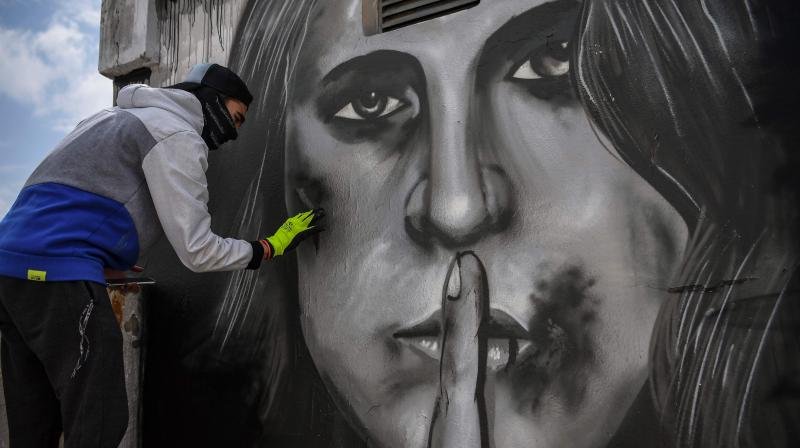A pandemic prompted lost agenda: Domestic Violence

Introduction
Barring the profound impacts of the COVID-19 pandemic on the medical and fiscal front, a domain that has squarely evaded our attention is the sharp escalation in gender-based violence. In an attempt to eliminate the prevalence of the deadly Coronavirus, countries all across the world have implemented lockdowns of varying proportions and formulated strict confinement policies. The mandatory quarantine measures have unleashed a new threat for women, a threat more fatal than the virus itself: Domestic Violence. In fact, the World Health Organisation had observed that gender-based violence would now be on the upsurge because of involuntary confinement to the domestic periphery.
Rising numbers
Closer home, the circumstances are wretched. Following the dinner-time announcement of a nation-wide lockdown by Prime Minister Narendra Modi on 24th March 2020, criticisms had begun to pour in from across the length and breadth of the country. While citizens questioned the credibility and efficacy of the hastily (un)planned lockdown, no questions were directed at the pandemic already lurking within the four seemingly safe walls. Studies by the WHO observe that one in every three women have been subjected to physical or sexual violence, at least once in their lifetime[1]. The obligatory quarantine measures and government’s “Stay Home, Stay Safe” appeal further worsened the situation for the survivors of domestic violence who were now locked down with their abusers. At this point, PM Modi’s allegory to the Lakshman Rekha for safe survival seemed rather ironic. The initial bubbles in India started simmering when the National Commission for Women (NCW) claimed a two-fold increase in the number of cases which were now lodged via emails and WhatsApp[2]. The number of complaints registered shot up alarmingly from 116 in the first week of March to 257 in the final week and 587 by mid-April [3]. Victims of a lockdown driven domestic abuse included both women belonging to the upper and middle classes as well as the poorer strata of society. Intensification of gender-based violence is an absolutely conceivable and archaic phenomenon for both sections. Thus, the questions to be addressed here are: (a) Why has the Pandemic and the subsequent lockdown emerging from inflamed domestic violence? (b) How has it taken a massive humanitarian toll at a time when women are juggling between personal and professional fronts?

The link between COVID-19 and Domestic Violence
India is currently shuffling between a Lockdown 5.0 and an Unlock 1.0. Over the last three months that Indians remained imprisoned in their homes, domestic violence cases have seen a 94% spike. In fact, Rekha Sharma, Chairperson of the National Commission for Women referred to the escalation as the ‘tip of the iceberg.’ She observed that the actual number might be even higher. Shutting down of offices during the lockdown period has made it an ordeal for that section who aren’t familiar with online procedures and lack the resources to do the same[4]. The sudden increase in new cases is not astonishing to the NCW who claims that 99% of the complaints were not new. Most of the complaints came from survivors who have been experiencing violence for several years and the isolation within homes has further triggered the exploitation of women[5]. A major reason that determines this subjugation relates to the return of migrant workers to their homes. Loss of jobs, lack of sources of income and the hardships following the lockdown has culminated into several men resorting to intimate partner violence. Such abuse resonates with the gender abuse that followed the 2008 economic recession and reinforced the connection between economic hurdles and domestic violence[6]. History is testimony to the recognition of women as a mere private entity; therefore home itself is a disaster for some of them. Data combined by the National Family Health Survey (NFHS) observes that for nearly 42% of men, beating their wives is a justified action[7]. This in fact, also speaks for the data that recorded one in every third woman in India to be a victim of violence (physical/sexual) at home. Economic crisis and restricted mobility due to defined access to modes of transportation also impair any scope of reaching out to friends and family for support or relocating to temporary shelters. Moreover, for women who identify as daily wage earners or migrant workers, the sudden lockdown has resulted in a massive humanitarian damage. Heart-wrenching images of such workers have determined the lockdown phase- thousands of women had been walking on foot to return home[8]. Economic distress has led many to even face starvation. No provisions- food or medical care had been announced by the government to delve into the crisis faced by them. Sanitation and hygiene protocols coupled with interpersonal violence will further aggravate the risk of a viral threat for this section.

Around the world
Recent observations from across the world have revealed that the global picture is no different. Unequivocally, the pandemic has injected pathos into the plight of women. They are at a loss of livelihood and engulfed in economic distress. For instance, countries in the MENA (the Middle East and North Africa) region lack the basic laws for the sustenance of women’s rights. Reports from Yemen, Egypt and Morocco suggest that nearly one-fourth of every woman has been subjected to physical abuse by their husbands. Tunisia observed a fivefold increase in cases of Domestic Violence since the curfew was implemented in mid-March [9]. Chinese city Jingzhou has recorded a threefold surge in domestic violence cases[10] alongside reports that poured in from nations like Germany, France, South Africa and so on[11]. Emergency helpline in Spain observed an 18% increase in a number of cases within the first two weeks of the lockdown[12]. Moreover, helpline numbers in Singapore and Cyprus have registered a nearly 30% increase in complaint calls[13]. Therefore, the situation marks for an urgent global response- either policy frameworks within the states or intervention by international organisations to uphold human rights.
Is there a way forward?
It is known for a fact that a deadly virus cannot be treated unless we develop a vaccine, but gender-based violence may be curbed to a certain extent through awareness and consciousness and a legal framework. For instance, if we look at the case of the lockdown in India, the responsibility lied with the government to have prioritised an issue as fragile as domestic violence and formulate policies accordingly. A national government-backed response would have been beneficial to categorically tackle issues like gender-based violence, mental health, etc. which stand at the risk of being fuelled by the pandemic. Policymakers must address this from the grassroots level, maybe by resorting to means of mass communication- radio, television, social media and so on. The need of the hour is for non-profits and civil society organisations to approach the scene and extend assistance to the victims- medical aid, legal assistance or even relocation to shelter homes if possible. Domestic Violence doesn’t come with a time-frame. Hence, its elimination is paradoxical without voluntary actions and awareness measures.

Conclusion
Amidst emergency responses to confront the
deadly Coronavirus, Domestic Violence as a relevant issue has almost become a
lost agenda. The virus has so far paralysed the world order and also crippled
the economy. Neglecting other crises that come in the way will surely result in
a massive humanitarian disaster. The longer the isolation extends, the tougher
it becomes for these vulnerable sections. Lockdowns will eventually come to an
end, viruses will gradually lose their prevalence but the virus named Domestic
Violence will linger around for ages to come. More than ever, it is now time to
revisit and alter the contours of gender-discriminatory discourse and strive
for achieving inclusivity in society.
[1] World Health Organisation (2020) Violence against women, 29th November
[2] Outlook India (2020) Blame it on COVID-19: Domestic Violence on the rise, are men putting more pressure on women? 20th April https://www.outlookindia.com/magazine/story/india-news-a-monster-at-home/303071
[3] The Hindu (2020) NCW records sharp spike in domestic violence amid lockdown, 15th June https://www.thehindu.com/news/national/nce-records-sharp-spike-in-domestic-violence-amid-lockdown/article31835105.ece
[4] The Telegraph (2020) Spike in domestic violence cases amid lockdown: NCW, 02nd April https://www.google.com/amp/s/www.telegraphindia.com/amp/india/spike-in-domestic-violence-cases-amid-lockdown-ncw/cid/1761424
[5]The Hindu (2020) No rise in Domestic Violence cases, says NCW Chairperson, 16th June https://www.google.com/amp/s/www.thehindu.com/news/national/ncw-no-rise-in-domestic-violence-cases-but-in-reporting/article31841409.ece/amp/
[6]VAWnet (2009) Economic stress and Domestic Violence, September https://vawnet.org/material/economic-stress-and-domestic-violence
[7] News18(2020) Every third woman in India suffers Sexual, Physical Violence at Home, 8th February https://www.news18.com/news/india/the-elephant-in-the-room-every-third-woman-in-india-faces-domestic-violence-1654193.html
[8] NDTV (2020) Pregnant woman, mother carrying 2 children- Long walk home amid lockdown. 6th May
[9] Deutsche Welle (2020) Coronavirus fuels domestic violence in the Middle East, 02nd April https://www.google.com/amp/s/amp.dw.com/en/coronavirus-fuels-domestic-violence-in-the-middle-east/a-52991848
[10] Sixth Tone (2020) Domestic Violence cases surge during COVID-19 Epidemic, 02nd May https://www.sixthtone.com/news/1005253/domestic-violence-cases-surge-during-covid-19-epidemic
[11] Council on Foreign Relations (2020) A double pandemic: Domestic Violence in the age of Covid-19 13th May https://www.cfr.org/in-brief/double-pandemic-domestic-violence-age-covid-19
[12] The New York Times (2020) A New Covid 19 crisis: Domestic Abuse rises worldwide, 06th April
https://www.google.com/amp/s/www.nytimes.com/2020/04/06/world/coronavirus-domestic-violence.amp.html
[13] UN Department of Global Communications (2020) UN supporting ‘trapped’ domestic violence victims during COVID-19 pandemic, 12th June https://www.un.org/en/coronavirus/un-supporting-%E2%80%98trapped%E2%80%99-domestic-violence-victims-during-covid-19-pandemic


















